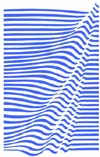|
A MEMS Vibrating Beam Gyroscope Fall 2003 (3 students), Spring 2004 (3 students) Advisor: Peter Saeta |

|
This year’s project continues the work of last year’s on vibrating beam angular rate sensors, but aiming to develop an over-size working prototype compatible with MEMS production techniques.
|
A MEMS Vibrating Beam Gyroscope Fall 2002 (5 students), Spring 2003 (5 students) Advisor: Peter Saeta |

|
Vibrating beam angular rate sensors were first proposed in the 1960s and have been manufactured in bulk since the 1970s. A high-Q prismatic beam vibrating in its fundamental resonance, and simultaneously rotating about the beam axis, experiences a Coriolis acceleration that induces a vibration perpendicular to both the driven vibration and the angular velocity. This induced vibration is proportional to the rotation rate, producing a signal that can be used to measure the rotation direction and rate. The team is investigating the feasibility of producing vibrating beam angular rate sensors using standard silicon micro-electrical mechanical systems (MEMS) technology.
|
Space Interferometry Mission (SIM) 2001-2002 Advisor: Richard Haskell One subsystem of the Space Interferometry Mission (SIM) is to measure the small change in distance between two fiducial points to an error of approximately 50 pm. The method for determining this change in distance involves the use of a heterodyne interferometer. By dithering the beam of the interferometer in a known pattern about a fiducial point on the face of a corner cube, it is possible to align the beam such that the distance measured is minimized. This ensures proper alignment of the interferometer and proper measurement of the distance. We will focus first on creating a test setup here at HMC, and then on using this setup to break down all of our sources of error, such that in combination with the more expensive setup at JPL, we can meet the 50 pm requirement. Proposal |

|
|
A Method for Beating the Diffraction Limit in Photolithography Fall 2000 (5 students), Spring 2001 (5 students) Advisor: Peter Saeta |
|
Etec Systems, Inc. is a worldwide leader in the designing, manufacturing, and marketing of mask-making solutions for the semiconductor industry. Our Clinic team is providing Etec with a feasibility study on a potential technology for tightening the focus point of a laser on the photoresist layer of a mask beyond the normal diffraction limit, enabling the writing of smaller mask features. We report both analytical and experimental results.
Optivus Technology uses a proton accelerator as a radiation source for treating cancer patients. The current method of attacking tumors with the proton beam has been successful, but Optivus would like to improve the treatment by using a raster-scanning technique, requiring a much tighter control on the beam intensity. Our goal is to develop an improved electronics system to process the output of a beam intensity detector, allowing a feedback loop to control the beam at a much higher bandwidth.
|
Innovation for the Next Generation Fall 1998 (5 students), Spring 1999 (5 students) Advisor: Richard Haskell |
|
Aerojet’s current Advanced Microwave Sounding Unit (AMSU) orbits the earth, passively measuring the intensity of particular microwave frequencies for meteorological purposes. The team has explored and analyzed a number of new and innovative technologies in an effort to reduce the size and manufacturing cost of the AMSU receiver subsystem. Extensive research was done to determine the fundamental properties of the different technologies in order to pinpoint their limitations and foresee possible advances. The team has proposed feasible alternatives to the design of the current AMSU.
|
Even Illumination Light Source Fall 1996 (3 students), Spring 1997 (3 students) Advisor: Richard Haskell |

|
The team designed and built a system for a massively parallel automated fluorimeter. The source provides bright, stable, spatially uniform light across the underside of the 11 cm by 11 cm sample tray in any six narrow bands in the visible and near UV spectrum. The team used compact high intensity arc lamps, holographic diffusers and dichroic optics to develop a system that outperforms the existing source at SAIC while costing one-third as much.
Designing and Modeling a High Intensity Deuterium Lamp
Fall 1996 (5 students), Spring 1997 (4 students)
Advisors: Graydon Bell and Bob Wolf
BHK requested a design for a deuterium lamp that has a higher output and greater lifetime than existing lamps on the market. The team developed a model relating to such parameter as fill composition, pressure, and geometrical measurements to the intensity and spectral characteristics of the output, and suggested and evaluated design modifications to improve performance.
|
Field-Widened Fourier Transform Spectrometer Fall 1996 (4 students), Spring 1997 (4 students) Advisors: Jim Monson and Bob Wolf |
|
The Fourier Transform Spectrometer (FTS) is a widely-used instrument for spectral analysis of thermal sources. The interferometry based FTS has a limited field-of-view (FOV). Gencorp/Aerojet has contracted the Harvey Mudd College Engineering/Physics Clinic team to determine the feasibility of a field-widened FTS. Extensive research has been carried out towards the understanding of both internal and external FOV constraints of the FTS. The focus on internal constraints has led to several interferometry design approaches; the most promising design utilizes a mechanically deformable cat’s eye mirror, which in place of the traditional plane moving mirror, allows for change in the curvature of the mirror as the cat’s eye is moved. Alternate designs include lens focusing systems and the addition of dispersive media. The team explored these prospective designs for a field-widened system through feasibility studies and performance evaluations.


